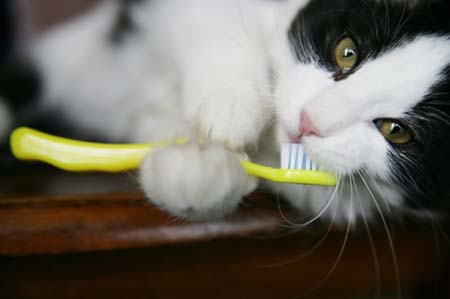
Pets are not people. Even with the best home care they are going to accumulate a lot more tartar than humans do. They have more bacteria, don’t brush as frequently, and are unable to floss. Tartar can build up on your pet’s teeth and lead to tooth root infections and tooth loss. The bacteria from your pet’s mouth can enter the blood stream and even lead to infection in other organs. This is why dental procedures are an important part of your pet’s care.
Animals, unlike people, have to under go anesthesia to have their teeth cleaned and to have dental procedures. A lot of owners are apprehensive about their pet going under anesthesia. It is for this reason that “anesthesia free” are becoming popular. There are even several sprays that are marketed that claim to make tartar disappear with just a daily spray on your pets teeth. Unfortunately, these methods aren’t effective at addressing your pet’s dental health, and in some cases may actually be more dangerous than general anesthesia.
The same principles of anesthesia in the article “No Surgery Is Routine” are applied in our practice for our dental procedures. When carried out correctly, general anesthesia is better and safer for your pet’s dental procedure than sedation or even being awake. During a dental procedure your pet’s teeth are “scaled” using a ultrasonic dental instrument just like the one used at a human dentist. This instrument sprays water. When your pet is under anesthesia their airway is protected from water, saliva, dental tartar, and blood by a tube in their trachea (endotracheal tube). This tube delivers oxygen and anesthetic gas while your pet is “asleep” (unconscious). It has an inflatable cuff towards the end of it that protects your pet’s airway by making a snug fit with their trachea. This prevents fluids and tartar from being inhaled into its lungs.
Sedation can be even more dangerous, because their reflex to swallow may be diminished from the sedation. For this reason your pet’s teeth have to be scaled by hand (using a simple instrument to scrape the tartar). If done incorrectly, this can damage the surface of your pet’s teeth. General anesthesia allows us to thoroughly examine your pet’s mouth, teeth and gums. It also allows us to take x rays and perform tooth extractions if needed. The level, or depth, of anesthesia can be adjusted minute to minute with a dial that controls the amount of anesthetic gas your pets receive. Sedation on the other hand, is not as easily controlled. Your pet is also not receiving high levels of oxygen while under sedation.
Anesthesia free dentistry is where no sedation or anesthesia is given to your pet. A thorough oral exam, extractions, or dental x-rays can NOT be performed. With a pet awake, it is impossible to thoroughly scale the inside and back surfaces of the teeth. There is also a risk of it inhaling a piece of tartar. The teeth may look ‘cleaner’, but little has been done to professionally address your pet’s teeth. Tartar (along with bacteria) will be left behind, and your pet may still have bad breath.
Lastly, there are dental sprays that have been marketed to remove tartar from your pet’s teeth. At the present time NO spray or product has been clinically proven (studies done and published in a medical journal) to thoroughly remove large quantities of tartar from your pets teeth. No spray has been proven to be so effective that it can replace having a dental procedure for your pet. If this was possible, we would have a spray we could use to replace brushing our teeth and going to the dentist to have our teeth cleaned.